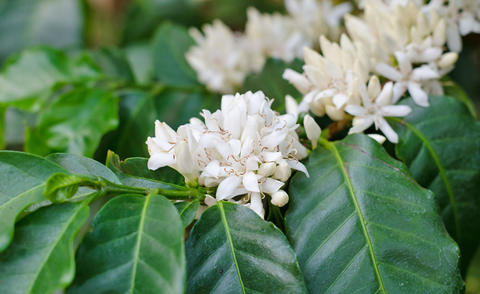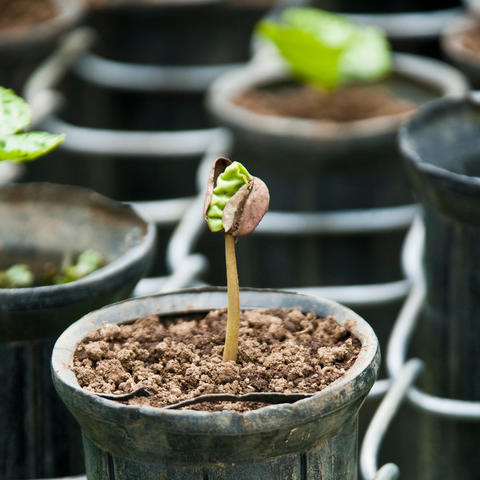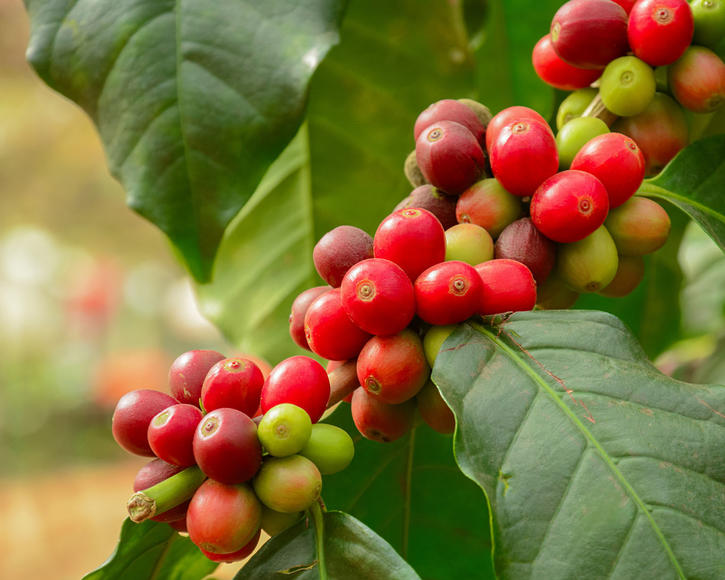Coffee plant
100 percent Arabica coffee? With these planting and care tips, your coffee plant may even develop its popular fruit indoors.
Factsheet
- Growth type
-
- shrub
- Growth height (from)
- from 100 cm to 200 cm
- Growth characteristics
-
- upright
- tight
- Flower color
-
- white
- Flowering time (month)
-
- April to May
- Flower shape
-
- under the table
- Bundles
- Flower characteristics
-
- strongly fragrant
- Leaf color
-
- green
- page format
-
- broad lanceolate
- full margined
- Sheet properties
-
- evergreen
- Fruit color
-
- red
- Fruit shape
-
- Stone fruit
- Light
-
- scattered light
- Soil type
-
- sandy to loamy
- Soil Moisture
-
- fresh to humid
- ph value
-
- weakly acidic to acidic
- Lime compatibility
-
- sensitive to lime
- Nutrient requirements
-
- nutrient-rich
- Humus
-
- rich in humus
- Decorative or utility value
-
- Flower Decoration
- Fruit ornaments
- Leaf ornaments
- Scented plant
- Use
-
- Interior greening
- Planters
- Winter garden
- Warm House
- Garden style
-
- Pot garden
The Coffee plant (Coffea arabica) is the most famous representative of its genus: Around three quarters of the global coffee harvest consists of the fruit from this species or its varieties. We’ve all seen ‘100 per cent Arabica’ on a coffee packet at some point or another.
This member of the bedstraw (Rubiaceae) family originates from the mountain forests of Africa, more precisely: from Ethiopia. However, it didn’t take long for the coffee plant to conquer the globe, a phenomenon which was driven in particular by large-scale cultivation in Arabia. The importance of Arabia as a cultivation area has receded in the meantime - however the botanical name continues to make reference to it. Today, the Coffee plant is cultivated in almost all countries with a suitable, that is tropical, climate. This is no surprise when we consider that coffee is one of the most popular drinks in the world. What’s new is that more and more hobby gardeners are having a go at cultivating coffee plants as a container plant indoors, in conservatories or in greenhouses. The Coffee plant is also great as an exotic fragrant plant in a conservatory.
The Coffee plant is an evergreen shrub with dense foliage. Coffea arabica forms an upright main shoot, from which branches shoot off horizontally over several levels. In a natural location, the Coffee plant reaches 10 to 16 feet tall, whereby crop plants are often capped in order to stimulate branching and thereby promote fruit growth. However, as s a container plant in our latitudes it rarely grows taller than three to seven feet.
The dark green, shiny leaves of the Coffee plant are wide, lanceolate and between 3.93 and 5.91 inches long. The leaf margins are slightly wavy. The leaves are abundant and sit opposite one another on the branches.

The coffee plant bears small, charming, white star flowers which form clusters in the leaf axils. They give off a pleasant fragrance. It generally takes three to four years before the first flowering.
Coffea arabica is considered ‘the’ coffee plant as its fruit delivers a particularly fine aroma and it has a less bitter taste than other species. The stimulating and invigorating effect of coffee is due to the caffeine, an alkaloid which is naturally present in high concentrations in the Coffee plant. However, more precisely it is not the cherry-like red stone fruit of the coffee plant which is used for making coffee, rather the maturing bean-shaped kernels inside (the seeds). Each fruit contains two coffee beans. They drop when they are mature.

Tip: If you want a Coffee plant for more than just a decorative container plant in the house and are actually interested in growing your own crop, you should boost fertilization with a soft brush. While Coffea arabica is the only self-fertilizing species of the genus, as a houseplant it nonetheless often requires a little help - as it does not reliably self-fertilize even with the best care. If the Coffee plant forms fruit, as soon as this drops it should be collected, opened and the gray-green seeds removed. Remove as much of the fruit flesh from the coffee beans as possible. There are different methods for making coffee, the classic method is: roast the seeds, grind them and brew them in boiling water. Voila! your home-grown coffee is ready!
A light location all year round is essential for the Coffee plant to thrive. However, avoid a place in direct sunlight. It is naturally used to a montane climate, room temperatures between 64 and 72 degrees Fahrenheit are sufficient. However, the Coffea arabica is sensitive to temperature fluctuations. As a true tropical plant, the coffee plant also requires constant humidity of at least 50 per cent.
Plant the coffee plant in fresh to moist and highly permeable soil with a high humus content. The recommended pH value is between 5.5 and 6.5, so in the acidic region. Ideally, you should mix some normal garden soil with sand and nutrient-rich compost soil.
You should only water the Coffee plant with soft, room temperature water. Always keep the root ball of the container plant moist, but without allowing waterlogging.
The Coffee plant should be given flower fertilizer weekly from April to September. In winter, fertilizing every four to six weeks is sufficient.

As a container plant, Coffea arabica needs a new pot on average every two years. The older the Coffee plant, the less frequently it requires repotting. Spring is the best time for repotting.
If the Coffee plant is cultivated as a purely decorative plant, pruning is generally unnecessary and at best only serves to keep the habitus attractive. Gentle shape pruning stimulates branching and ensures a denser foliage. The shrub can also be readily thinned if desired. Older Coffee plants should be thinned from time to time.
As Coffee plants have a natural resting phase from November to March, they require different care during the winter months than they do for the rest of the year. During this time, place the container plants in a somewhat cooler spot, although the temperature should drop not below 59 degrees Fahrenheit. Coffea arabica always crave light, so make sure it has a bright spot. It requires less watering in the winter, however the roots should never be allowed to completely dry out.
The varieties of Coffea arabica have enticing names such as ‘Mocca’ or ‘Buorbon’. However, these are more relevant for professional coffee cultivation than for home use. Therefore, only the main species is generally offered in regular garden centers.

The Coffee plant is propagated through head cuttings or sowing seeds. If you have suitable seeds, you need to be quick, as Coffea arabica seeds quickly lose their ability to germinate. Soil temperature of 77 degrees Fahrenheit, a constantly moist substrate and high humidity are required.
Dry room air promotes pest infestation. Scaly insects, mealy bugs and spider mites in particular can bother coffee plants. However, fungal diseases, in particular in the root area, are much more dangerous and often result from waterlogging in the pot.

